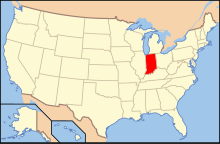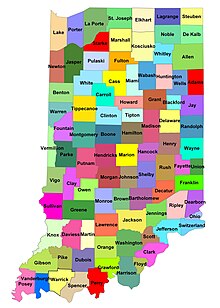|
Overview of and topical guide to Indiana
 The location of the state of Indiana in the United States of America The location of the state of Indiana in the United States of America
The following outline is provided as an overview of and topical guide to the U.S. state of Indiana:
Indiana – a U.S. state, was admitted to the United States as the 19th state on December 11, 1816. It is located in the midwestern United States and Great Lakes Region of North America. With 6,483,802 residents, as of the 2010 U.S. Census, the state is ranked 15th in population and 16th in population density.[1][2][3] Indiana is ranked 38th in land area[1] and is the smallest state in the contiguous U.S. west of the Appalachian Mountains.[4] Indiana's capital and largest city is Indianapolis,[5] the second largest of any state capital and largest state capital east of the Mississippi River.[citation needed]
General reference
 An enlargeable map of the state of Indiana An enlargeable map of the state of Indiana
Geography of Indiana
Geography of Indiana
Places in Indiana
Environment of Indiana
Natural geographic features of Indiana
Human-made geographical features of Indiana
Regions of Indiana
 An enlargeable map of the 92 counties of the state of Indiana An enlargeable map of the 92 counties of the state of Indiana
Administrative divisions of Indiana
Demography of Indiana
Demographics of Indiana
Government and politics of Indiana
Politics of Indiana
Federal government in Indiana
Elections and political parties in Indiana
Branches of the government of Indiana
Government of Indiana
Executive branch of the government of Indiana
Legislative branch of the government of Indiana
Judicial branch of the government of Indiana
Courts of Indiana
Law and order in Indiana
Law of Indiana
Military in Indiana
Local government in Indiana
History of Indiana
History of Indiana
By period
 The location of the state of Indiana in the United States of America The location of the state of Indiana in the United States of America
 An enlargeable map of the state of Indiana An enlargeable map of the state of Indiana
 An enlargeable map of the 92 counties of the state of Indiana An enlargeable map of the 92 counties of the state of Indiana
- Indigenous peoples
- French and Indian War breaks out, British capture the French outposts in Indiana, 1760–1761
- American Revolutionary War, April 19, 1775 – September 3, 1783
- Northwest Territory, (1787–1800)–1803
- Treaty of Greenville signed, opening part of Indiana for settlement for the first time by Americans, 1795
- Territory of Indiana, 1800–1816
- State of Indiana becomes 19th state admitted to the United States of America on December 11, 1816
- Treaty of St. Mary's is signed, opening most of central Indiana for settlement, 1819
- Bank of Indiana created, 1832
- Indiana verges on bankruptcy, almost all of the state's public works are liquidated by the creditors, 1841
- Treaty of the Wabash signed, opening most of northern Indiana to settlement, 1840
- William Henry Harrison becomes ninth President of the United States on March 4, 1841
- Mexican–American War, April 25, 1846 – February 2, 1848
- Indiana's population exceeds 1 million, 1850
- Indiana adopted a new constitution, 1851
- Abraham Lincoln becomes 16th President of the United States on March 4, 1861
- American Civil War, April 12, 1861 – May 13, 1865
- Indiana Gas Boom begins, 1884
- Natural gas supplies run low, ended the boom, 1905
- Benjamin Harrison becomes 23rd President of the United States on March 4, 1889
- Vietnam War, September 26, 1959 – April 30, 1975
- Indiana adopts a series of constitutional amendments that alter the makeup of the government, 1970–1971
By region
By subject
More
Culture of Indiana
Culture of Indiana
The arts in Indiana
Sports in Indiana
Sports in Indiana
Economy and infrastructure of Indiana
Economy of Indiana
Education in Indiana
Education in Indiana
See also
References
External links
 Wikimedia Atlas of Indiana Wikimedia Atlas of Indiana
|










